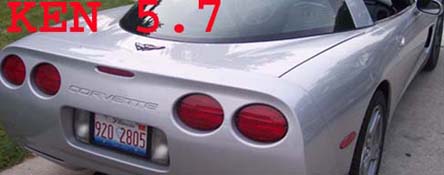i have a 2.2 SOHC and i was just wondering if my stock connecting rods could handle 12-15lbs of boost from a t-25 or t-28bb turbo? i thought about getting a set of eagle rods but the cheapest i can find them are like an extra 350bucks...any help, and oh btw i cant get to my car right now b/c im currently in iraq...

thanks for any help
2001 Ford F250 Superduty
7.3L PowerStroke Diesel
5" Turbo-Back Exhaust
XCal-2 With Tadds Tunes
Water/Methanol Injection
aFe Stage 2 Intake
Full Set of AutoMeter Gauges.
Dont you mean OHV the is no SOHC 2.2 any Your going to need a bigger turbo than a t25, try looking more for a T3 super 60. My 2200 handled 10 psi all daylong with no prolbems

will a t-28bb do the job... and yeah my bad it is ohv

im new to j-body tuning but i love to rip that thing apart..i already had to put a new trans in it cuz i spun the 2nd gear synchro...
2001 Ford F250 Superduty
7.3L PowerStroke Diesel
5" Turbo-Back Exhaust
XCal-2 With Tadds Tunes
Water/Methanol Injection
aFe Stage 2 Intake
Full Set of AutoMeter Gauges.
You can run stock internals on 12-15 psi IF YOU HAVE A SOLID TUNE. T3 60-trim minimum.

fortune cookie say:
better a delay than a disaster.
and besides... if you do end up shattering a connecting rod, they're EACH about $120 from the dealer for oem parts. i learned the hard way.
 JBO Stickers! Get yours today!
JBO Stickers! Get yours today!
Rich Grayo Jr. wrote:and besides... if you do end up shattering a connecting rod, they're EACH about $120 from the dealer for oem parts. i learned the hard way.
But, when a connecting rods goes, it doesn't go quietly. It likes to take the piston, cam, and even the block with it...

fortune cookie say:
better a delay than a disaster.
and i was wondering what a good compression ratio would be if i want to run 15-17 pounds of boost? and i found a super 60 turbo rebuilt for $389, i was also wondering if that is a good deal and i should jump on it? Thanks
2001 Ford F250 Superduty
7.3L PowerStroke Diesel
5" Turbo-Back Exhaust
XCal-2 With Tadds Tunes
Water/Methanol Injection
aFe Stage 2 Intake
Full Set of AutoMeter Gauges.
I personally would lower the compression to 8:1 but that's just me. If you want to run the stock bottom end, you'll need all the extra insurance you can get. Lower compression, turned back timing, plenty of fuel, and a solid spark. Which means MSD or HPT for the timing (HPT for fuel too if you go that route), the proper injectors, fuel pump, FPR, MSD coils to keep the spark strong, prolly a colder plug, like a TR6 or something. Those seem to be popular. Definitely want to run a good FMIC, and you're gonna want to get a really good tune on it to make sure you get everything working right. I'm sure Slow or Notec will have some other input.
Personally i wouldn't run that much boost on a stock 2200, but if you're gonna do it, there's an idea of what you need. If I were you, I'd be stepping up to forged internals. Like already said, stock rods are $120 each, forged ones can be had for $400 or so for the set. Same with the stock pistons. I wouldn't trust them at 17psi without some serious tuning and a twilight vigil.

gotcha..i like the twilight vigil...lol anyway i have msd coils already and 8:1 is kinda low... the only thing i think im going to keep stock in the engine is the crank and im gonna have that balanced and lightened... any other suggestions?
2001 Ford F250 Superduty
7.3L PowerStroke Diesel
5" Turbo-Back Exhaust
XCal-2 With Tadds Tunes
Water/Methanol Injection
aFe Stage 2 Intake
Full Set of AutoMeter Gauges.
Get the fuel and ignition right, that's the msot important thing. When you're going boost, even at 5 or 6psi, you need to have it right. But at 15psi and higher especially, well fuel and timing are the tyrannical king and queen.
As far as the compression ratio, trust me, 8:1 isn't all that low in terms of a boosted engine. The reason you do that is to ease the stress on the internals and decrease the chance of detonation. Think of it as cheap insurance. You're going to be stuffing a lot of air and fuel in there and a higher compression ratio is more prone to detonation and even the cylinder pressures alone can do some damage. And the power loss due to lower compression can be easily negated by the extra boost that the lower compression will allow you to run. You can, however, get away with a stock 8.5:1 on forged internals but I like to be safe when going with that much boost. Especially since the engine will likely be run on pump gas the majority of the time.

yes it will be running on pump gas... stock compression is 8.5:1 on the 2.2? i thought it was higher... i think i will go the forged internals route... www.importperformancepart.com makes a 2200 engine kit but it doesnt include connecting rods

. and thats another 400 bucks...
2001 Ford F250 Superduty
7.3L PowerStroke Diesel
5" Turbo-Back Exhaust
XCal-2 With Tadds Tunes
Water/Methanol Injection
aFe Stage 2 Intake
Full Set of AutoMeter Gauges.
Yeah I'm pretty sure it's 8.5:1, it might be 9:1 but I can't remember off the top of my head. I know the pistons I just got for my rebuild are 8.5:1. I do know the stock bore is 89mm and I believe the stroke is 86mm, just in case you need the specs when you order the new internals.

thanks... oh and im sorry.. just to clarify things i wont be running 15-17 lbs of boost all the time...

that would be insane... i just wanna be sure the engine is strong enough to handle that when i go to the track...
2001 Ford F250 Superduty
7.3L PowerStroke Diesel
5" Turbo-Back Exhaust
XCal-2 With Tadds Tunes
Water/Methanol Injection
aFe Stage 2 Intake
Full Set of AutoMeter Gauges.
You know it jsut occurred to me you're building a 2002 Cavalier. The 2.2 after '98 was a bit different than the pre-'98 like mine. From the info I found for the 2200, the bore is still 89mm but the stroke is 88mm, and the compression ratio is 9.0:1. I'm thinking in terms of the older LN2 which I may even be off on the stroke on that one too.

2.2L = 8.85:1, 89mm/88mm
2200 = 9.0:1, 89mm/88mm (the displacement didn't change, hence them both being 2.2L

)
I wouldn't lower the compression. That is done by the OEM to allow cheaper manufactured parts, and a rougher/leaner tune. My boost motor is currently looking like 9.8:1, and I'm planning up to 20psi with alcohol/water injection. Stock Ecos are 10:1, and they handle boost fine, even on a rough tune. If you want to minimize detonation, polish everything in the combustion chamber to a mirror finish, eliminate sharp edges, keep a tight quench distance, open the plugs towards the exhaust valve, and keep the motor cool.

fortune cookie say:
better a delay than a disaster.
Josh is a braver man than I lol. But he's right about polishing everything in the combustion chamber and what not. I think we could go back n forth all day about why or why not to lower compression for boost. Some do it, some don't. Some even raise it. I tend to go the lower compression route but that's just me.

ln2johnny wrote:Josh is a braver man than I lol. But he's right about polishing everything in the combustion chamber and what not. I think we could go back n forth all day about why or why not to lower compression for boost. Some do it, some don't. Some even raise it. I tend to go the lower compression route but that's just me.
Dyno queens lower it, race cars raise it

Those 1000+hp supras run 40+psi on very low compression, as a result they have a very narrow power band. Heck, I can't stand the stock compression on my DSM, it makes it very sluggish when daily driving.
Also consider the camshaft, dynamic compression is what actually matters.

fortune cookie say:
better a delay than a disaster.
OHV notec wrote:ln2johnny wrote:Josh is a braver man than I lol. But he's right about polishing everything in the combustion chamber and what not. I think we could go back n forth all day about why or why not to lower compression for boost. Some do it, some don't. Some even raise it. I tend to go the lower compression route but that's just me.
Dyno queens lower it, race cars raise it  Those 1000+hp supras run 40+psi on very low compression, as a result they have a very narrow power band. Heck, I can't stand the stock compression on my DSM, it makes it very sluggish when daily driving.
Those 1000+hp supras run 40+psi on very low compression, as a result they have a very narrow power band. Heck, I can't stand the stock compression on my DSM, it makes it very sluggish when daily driving.
Also consider the camshaft, dynamic compression is what actually matters.
I guess that makes the GVR4 sitting in my garage as we speak, a dyno queen

We lowered the compression just a smidge so we can run higher boost numbers, and changed the cams and what not. Granted, it's a total track slut and will likely never see the street again, but yeah like I said we could go back n forth on this all day, bro.

OHV notec wrote:Rich Grayo Jr. wrote:and besides... if you do end up shattering a connecting rod, they're EACH about $120 from the dealer for oem parts. i learned the hard way.
But, when a connecting rods goes, it doesn't go quietly. It likes to take the piston, cam, and even the block with it...
NOt to mention the fact you are going to OR SHOULD be placing new gaskets all around after opening her up, and the head bolts are Torque to yeiled if I remember correctly.. another thing to replace....
 My Cav
My Cav
I give up...
i'm buying a VW those people love trees, so they should love eachother too... "Andy"
^^ Which, btw, are apparently not included in the typical rebuild kit. I ordered a master rebuild kit complete with new cam, oil pump, seals, rings, pistons, the whole nine, but no head bolts. Fukkers. You'd think for damn near $500 they'd throw in some head bolts.













Those 1000+hp supras run 40+psi on very low compression, as a result they have a very narrow power band. Heck, I can't stand the stock compression on my DSM, it makes it very sluggish when daily driving.


